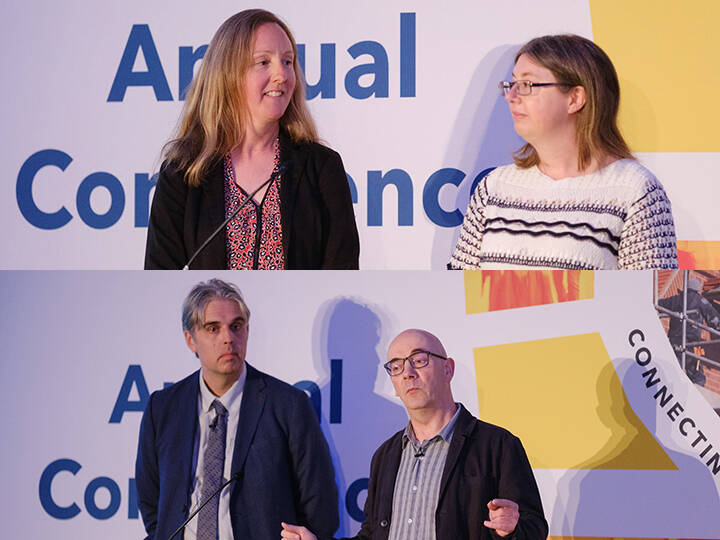Stuart Andrews’ presentation focused on the Valuation Office Agency’s (VOA) journey toward integrating more robust, standardised address data into its systems—transitioning from legacy structures to a model that aligns more closely with official address datasets and geospatial standards.
Recordings of the 2025 conference talks can be found here
While much of the groundwork echoed themes introduced earlier in the day—especially around address interoperability—Stuart offered a deep technical dive into what such transformation looks like in practice.

With a professional background in geomatics and geospatial data architecture, Stuart brought both subject-matter expertise and system-level thinking to his role at the VOA. His core argument was that the VOA does not operate in isolation: it is one node within a larger address ecosystem that spans local authorities, Royal Mail, HM Land Registry, and central systems like GeoPlace and AddressBase. He emphasised the importance of recognising the VOA’s role not just as a user of addresses but as a contributor to the way addresses move and mutate through this network.
Stuart illustrated the data journey with a detailed schematic of current workflows, particularly around council tax assessments. He explained how data originates in local authorities’ LLPGs (Local Land and Property Gazetteers), is transformed—often manually and inconsistently—by billing authorities, and is then passed to the VOA in report formats that require further transformation and abbreviation due to legacy system constraints. These transformations frequently introduce inconsistency and information loss, making it difficult to maintain clean, reliable address records.
He focused on two critical transformation points: one within local authorities, and another where abbreviated reports are sent to the VOA, prompting further internal interpretation. These stages highlighted inefficiencies and introduced risks that could undermine the integrity of official address data. For example, constraints within the VOA’s central system had previously led to systematic abbreviation of incoming address data—reducing rich, structured records to truncated fields barely suitable for administrative use.
Core architecture
Stuart then examined the core architecture of the VOA’s legacy systems. Built in the 1980s, the system featured a series of address fields—firm occupier, name/number, multiple sub-streets, postcode, etc.—that failed to cleanly distinguish between primary and secondary address information. In many cases, both types of data were placed within a single field, undermining field meaning and making automated interpretation highly unreliable. The same street could contain addresses parsed in radically different ways, depending on how the data had been entered.
To address this, Stuart and colleagues seized the opportunity provided by a major IT transformation programme. As a data architect on the project, he influenced the structure of a new administrative system designed to handle address data differently. Crucially, the new system connects directly to the OS Places API—providing access to the authoritative data derived from LLPGs. Both the new VOA admin system and a new local authority portal are designed to draw from this same authoritative source, allowing address records to be selected rather than manually rekeyed or reinterpreted.
This change has enabled the VOA to start storing more granular and accurate address components, including UPRNs, coordinates, and hierarchical relationships such as parent UPRNs. It has also allowed for structured parsing of sub-building information (e.g., flats, units), building names, street-level data, locality, and postcode. Address records added to the system now reflect their official form as defined in OS Places and are clearly marked as official UK addresses.
In practice, this has meant a step-change for VOA council tax data, which now pulls directly from trusted, standardised sources. This approach significantly reduces the risk of divergence and removes the burden of interpretation from internal teams. It also improves the visibility and traceability of address lineage—from LLPG through OS Places to VOA database.
Implementation challenges
Stuart was candid about the implementation challenges. While the technical design and intent were strong, issues emerged around developer interpretation, validation logic, and user processes. Contractors sometimes misapplied formatting logic, and users accustomed to legacy workflows needed support to adapt. Nonetheless, he stood firm in his belief that the new approach—consuming official address data rather than generating VOA-specific versions—is the correct long-term strategy.
He confirmed that the VOA would, in the short term, continue to create addresses where required under legislation, but the strategic goal is to rely on authoritative addresses curated by local authorities. The new system has been architected to support this future state by embedding UPRN use from the outset.
A significant amount of the council tax address data currently in the system is already marked as official, with continuing efforts underway to complete the remainder and to extend the same model to non-domestic rating (NDR) addresses. The structure of the data now closely aligns with British Standards, and the content is increasingly being cleansed and validated to meet those standards as well. On the question of whether the BS7666 standard supports VOA use cases, Stuart was clear: while the relationship between properties and addresses is often many-to-many—especially for complex sites like hospitals or subdivided buildings—the standard remains fit for purpose. He encouraged a mindset shift away from expecting one-to-one mappings, noting that relational data structures (e.g. junction tables) can accommodate complexity without undermining clarity or function.
In conclusion, Stuart outlined a strategic shift in how the VOA is managing address data: moving from passive recipient and transformer of imperfect inputs, to active consumer of authoritative, structured data. The underlying systems now support this model, and the VOA’s role within the national address ecosystem is beginning to evolve accordingly. While there are process and implementation hurdles to navigate, the vision is clear: a fully interoperable address data system, designed with long-term integrity, user clarity, and national consistency in mind.



